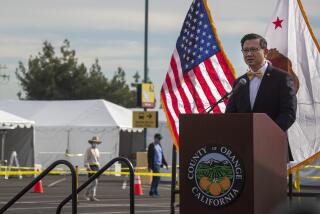Petition Count to Slow Valley Secession Drive
In a setback for the San Fernando Valley secession movement, officials concluded Wednesday that they must check all 202,000 signatures collected on petitions authorizing a study of a breakup’s impact after a random sample of signers uncovered a high rate of duplicates.
Los Angeles County Registrar-Recorder Conny McCormack projected that, based on the sample, secessionists would fall about 2% short of the signatures needed--a development quickly seized upon by proponents and opponents of breaking up the city.
Opponents said the sample shows support is lacking, while secession boosters claimed that McCormack’s procedures were faulty.
The sample of 3%, or 6,075 signatures, found that 1,441 were bad, and discovered 24 signatures from people whose names had already been found amid the random petitions checked--an unusually high rate of error, according to McCormack.
Projected to the full number of signatures, the petitions appeared to contain 97.6% of the 131,771 signatures needed to move the secession drive to the next stage: an unprecedented study tallying and divvying Los Angeles’ massive tangle of assets and liabilities.
That is because county elections officials, using a complex formula developed by the secretary of state to authenticate signatures, concluded that as many as 25,877 duplicates could exist among the full roll of petitions.
“It’s going to be close,” said Director Larry Calemine of the county Local Agency Formation Commission, which oversees the secession process.
McCormack said the check of all signatures will begin Monday and is not expected to be completed until March at the earliest. At that time, under state law, proponents will have a final period of 15 days to collect more signatures.
Under a deal approved last month by the county Board of Supervisors, the county and the city--not secession proponents-- will pick up the tab, expected to be about $270,000.
Leaders of Valley VOTE, the group pushing the secession drive, charged that obstacles were being thrown in their path.
Although secession proponents always suspected that a full count might be required, they were dismayed Wednesday, claiming the sample clearly showed stronger-than-needed support.
A total of 76% of the sample signatures were valid, supporters noted, a rate that would produce more than enough valid signatures if applied to all petitions collected.
“I see no logic in their explanation,” said Valley VOTE Chairman Richard Close. “They found 24 duplicates! That’s minuscule. If there’s only a few duplicates in the sample, there’s probably the same percentage in the full count. It defies logic, and it would be a waste of taxpayer money for the county to check all of these signatures. We have enough!”
Close said secession leaders plan to talk to lawyers.
“I hope this is not another Van Nuys Air Show,” Close said, referring to a highly publicized incident last year in which secession advocates where shut out of a public event. As a result of the flap, secession backers obtained a settlement from the city and were awarded extra time to canvass for signatures.
Even if secession proponents fail in their initial bid to kick-start the breakup, they will not have to begin anew. Under the unorthodox laws governing secession, the petitioners would be given 15 days to collect signatures if they come up short on the first full count. Those signatures would then be checked and added to the previous total.
Proponents of charter reform as an alternative to Valley secession said the random sample indicated that support for a break from Los Angeles may not be as strong as believed.
“I have always been skeptical about the desire of the Valley to secede,” said Councilman Mike Feuer, who represents some of the areas considered secession hotbeds. “I always suspected the support was inflated. I believe there are legitimate concerns about representation and the lack of responsive government, but charter reform is clearly the better tack to take.”
Feuer said secession proponents appear to want special treatment from elections officials.
“If Valley VOTE wants their signatures checked on the basis of a random sample, then they have to deal with the rules governing random samples,” he said.
A study must take place before secession could be placed on the ballot, which is not likely before 2002. For the issue to be placed before voters, the study would have to conclude that creation of a Valley city--which would instantly be the nation’s sixth largest--would be economically feasible, and that it could take place without hurting the rest of Los Angeles financially.
More to Read
Sign up for Essential California
The most important California stories and recommendations in your inbox every morning.
You may occasionally receive promotional content from the Los Angeles Times.










